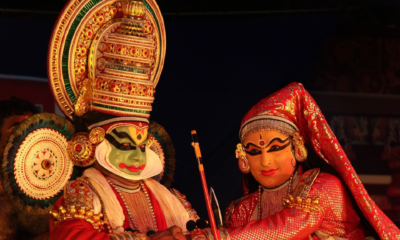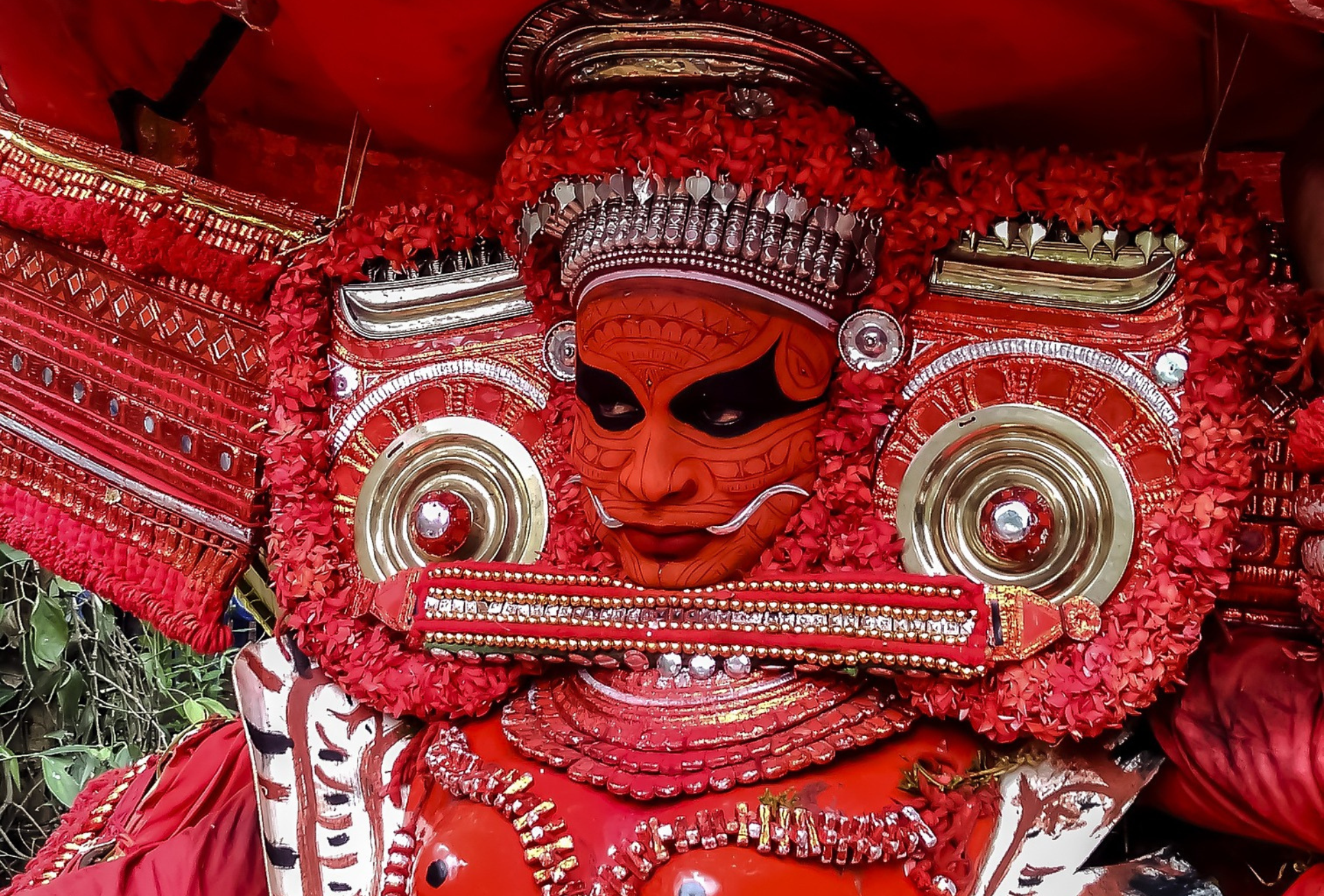A place that is full of mystery and magic, Kerala commonly known as God’s own country can be best described by the stunningly beautiful landscapes covered with soothing green where coconut palms gently sway to a tropical breeze while backwaters veiled in golden sun weave their captivating charm. Apart from being paradise where you get to feel like ‘God’s Own Country’, Kerala is a sheer spectacle of nature and along with its cultural extravaganza, it has so much more in store for the world than they can ever imagine.
The story of Kathakali makeup, the beat of Chenda drum and grace in Mohiniyattam dance speaks to a history or myth through each watery brushstroke. Similar to threads woven legendarily into a colorful tapestry, each of Kerala’s distinct art forms bring out the human story in a myriad that transcends man’s paltry time— retelling ancient epics and folklore entitled through generations. Picture a land with colors painted in every wall, alive and whispering the secrets of ancient traditions at you eye.
From the dramatic performances of Theyyam, where deities dance amongst us to soulful melodies in Sopana Sangeetham reverberating through temple corridors — Kerala’s art forms offer a stunning concert of colours and sounds. As they intimidate with their dedication, and the craft becomes an out of body experience for both audience members and performers. As you read ahead, this blog is an invitation to take a journey through the multiple artistic expressions that are prevalent in Kerala and encounter with some of the magical touch point which will make them not just performances but living heritage.
A mesmerizing representation of art from Kerala, Kathakali dance drama is a form showcasing vivid expressions through storytelling using fierce repertoires and body movements along with the elaborate costly attire. It is the traditional dance- music and drama of Kerala, which portrays a rich cultural tradition in India with expressive action-packed narratives.
Every performance of Kathakali narrates an interesting story from some Hindu mythology or Epics like Ramayana and Mahabharata. The grand makeup, popularly known as ‘pachas,’ ‘kathi,’ ‘thaadi’ and even the back in days used for female roles called minukku reveals several archetypes which is basic character building blocks varying from noble hero to fearsome demons. Performers called ‘artists’ train hard to learn the complex footwork, use of hand gestures or Mudras and eye movements also known as Navarasa that express a range of emotions.
Music that comes together with the staccato beats and haunting melodies of a Kathakali dance drama takes storytelling to an entirely different level, lending perspective whilst enriching theatrical experiences. Woven into the fabric of this experience is a peak at an opulent cultural tapestry that sparkles with magical traditions and artistic brilliance via avenues such as kathakali, Kerala’s classical dance.
One of the most important parts of the rich heritage and culture in Kerala is Theyyam, a captivating ritual dance style native to it. Theyyam, famous for bright costume clothes in vivid colors and decorative or specially made up with complex patterns on faces is a presentation of the religious aspects of North Malabar area offering stories inspired from belief system prevalentression. Laden with the enigmatic soul of Kerala, this art form stirs the curiosity and sparks an interest in both tourists as well locals. 2.
Visually appealing forms depicting mythological stories in reverence to divine deities, the different renderings of Theyyam beat up various Art Forms of Kerala into a pulsating dance low and some doping! These intricate ceremonies and choreographed routines offer a vibrancy that almost hypnotises onlookers with the spectacle. The practice, which has evolved over the years to turn into a liberal one of expression and sexual freedom through artistry is then performed in public or private by male professionals (called dancers) who are mostly young men with attractive features dressed as women accompanied by music.
Unraveling the Mystical Art Forms of Kerala’s Vibrant CultureBeen VerseTheyyam, where tradition mingles with artistic expressions. With its elaborate dance movements, costumes and music that moves the soul Theyyam is a beautiful escape from just being an exceptional performance art form.
One such mesmerizing classical art of those vibrant culture was the graceful dance from Kerala, Mohiniyattam or “Dance of The Enchantress”. It is like an art which encompasses beauty, grace with a blend of story-telling in the form or gestures and expressions. From the wide range of Kerala art forms, Mohiniyattam has a special significance reflecting the rich heritage and cultural depth of this region.
The magical and enchanting movements of Mohiniyattam leaves the audience spell-bound with its fine footwork, lyrical dancing lines as well mesmerising eye techniques that change expressions through a vast range emotions behind every single drama-scenes. The dancers clad in traditional dress bejewel the lore and fable that mystically moves its viewers to a spiritual environment.
The seamless moves and mesmerising expressions onstage make Mohiniyattam dancers reflect the aura of a seductress, dancing their way into hearts simply by conquering rhythm. An iconic numeral in the glory of cultural communities, this classical dance depicts Kerala’s rich heritage and is entwined with ancient customs to captivate spectators.
The classical music of Kerala is a captivating masterpiece. Kerala Heritage State Kailpolil Sahitya Writan Sootharufreq Art Forms KPSC Password Test the authentic subject in konkanni test is a tribute to these art forms that are part of Kerala’s rich cultural fabric. Each art form carries the soul and spirit of Kerala’s arts heritage, right from the melodious strains of Carnatic music to Kathakali — one which combines intricate dance movements with unique mime techniques.
Each performance also echoes with the melody of Kerala’s classical music and nadaswaram, enthralling viewers through their complex rhythms and emotions. A classical music maker carefully crafts their trade with techniques handed down over hundreds of years generationally.
Those who sing the classical music of Kerala do not entertain, but experience divine union. The veena, mridangam and vocal harmonies would propel listeners into a realm of music beyond words— in direct dialogue with the spirit.
The mystery of Kerala’s dance and art forms are a treasure trove waiting to be explored. Kerala’s music, dance & theater are the way in which its artists communicate their deepest emotions and inherent culture. Kerala’s classical music will always be, enticing loyal audiences from around the world and ensuring that its heritage remains very much alive in this day.
An ancient martial art form of Kerala is Kalaripayattu, which derives the cultural heritage and traditions. Kalaripayattu — a traditional combat form from the Indian state of Kerala, this involves strikes and kicks but also intricate movements along with self-defense techniques & some element of spirituality. Kalaripayattu has been practiced for centuries and it is much more than a physical art, rather an integral part of the lives that have lived through this beautiful land.
The practitioners, who are also known as kalari warriors in some regions of the world can display their skills to defy the strength and move with agility. Warriors are trained in many forms of combat—ranging from simple strikes, kicks and grabs to more dangerous combinations as well weapon work. Every move in Kalaripayattu is exact and resolute which places a great deal of emphasis on direct action-combat as well as reasoning-defense mechanisms.
Kalaripayattu holds a special place in the rich culture of Kerala, as it represents the bravery and martial spirit for which they are known. This enduring legacy can still be witnessed in several traditional performances, rituals and festivals performed across Kerala stating the influence of this art form on cultures in that region.
Peeling the layers off Kerala’s rich culture unravels a deeper connection between Kalaripayattu and what is the core essence of traditional heritage in Kerala.
Let the artistic creations of mural paintings take you to land that is vibrant in culture — welcome to Kerala. Kerala has a rich artistic heritage and this traditional art form holds much importance in it. The mural painting and the use of elaborate design that creates a level of mystique to murals full with bright colors.
The art forms of Kerala are diverse ranging from Kathakali to Theyyam ritual. Every art form speaks a story or the other — voice echoing in its own cultural platform. Mural paintings of Kerala are an epitome example which portrays the dexterity and aptness of local artisans.
Over the years, different art forms of Kerala have been nurtured and maintained by tradition but also evolved through time with innovation. The mural paintings appear vibrant and full of life, displaying beautiful patterns and motifs along with depictions from Hindu mythology that exhibit the profound spiritual aspects of the land.
As you unravel the magical art forms of Kerala, you will be drawn by everything that each brushstroke represents. Transport yourself to Gods own country and let the timelessness of mural painting display before your eyes.
Enigmatic Kerala has one of the richest handicraft traditions in India, highlighting its rich culture and grandness. With its mystique and beauty, Kerala has many art forms from intricate wood carvings to vibrant mural paintings that capture the visitor.
Another point, the crafts of Kerala are traditional and it shows in all items which is nothing less than work on professional hands. The knowledge of skilled artisans is handed down from generations to come, their skill passing on the art forms as well.
You can go through the collection of a wide variety of Kerala handicrafts from famed Kathakali masks to stylish coconut shell carvings and traditional handloom textiles. More importantly, every artwork contributes to narrating the historical lineage and artistic brilliance of this region.
Dive into the mystical land of Kerala with this handicrafts and get to see what magic artisans can actually do. Learn about the captivating motifs, colourful hues and intriguing designs that are exclusive to Kerala art forms.
Kerala is famous for its cultural heritage and the state celebrates numerous festivals all through the year. They show the various cultural diversity of Kerala from traditional art form to daily ritual.
The traditional art forms are one of the attractions in this cultural fiesta of Kerala. Right from Kathakali to Mohiniyattam, these performances literally sway people with their moves and the ornate costumes worn by them. Every dance form narrates a different tale, mostly from the ancient mythology or folklore reflecting onotr olden culture and tradition of Kerala.
Festival Season in Kerala is a treat for eyes with vibrant processions and traditional music along with dance performances on streets Onam – This is a harvest festival marked by magnificent feasts, boat races and flower decorations that bring all people together.
The cultural calendar of Kerala is perfect while revealing a range from artistic pieces to ancient traditions that have managed so far in the 21st-century millennia. What makes the experience more fulfilling is reading Kerala through these art forms from their true roots.
Even the traditional art forms of Kerala deeply rooted in its rich cultural heritage, have been affected by changing fashion. While the established forms of Kathakali and Mohiniyattam, among others are morphing to include contemporary themes or new methods in storytelling bringing a more inclusive audience form outside Kerala.
The art forms of Kerala have always mirrored its society, and they seamlessly evolve with time but retain their essence even today. Musicians and dancers are integrating the traditional with ears attuned to pop culture, bringing a different energy into ancient traditions.
Taking the traditional art forms of Kerala to global audience, digital space is making it possible today for people from all around the world can see how beautiful and intricate these ancient are. Not only is that preserving these art forms, but it also sustains them so they can be passed onto the next generation to appreciate and love.
Modern influences have injected new life into Kerala’s classical arts, maintaining their societal relevance in a world speeding out of control and still honoring the cultural heritage they document.
Kerala’s colourful cultural canvas is interwoven with myriad art forms that are as old as the hills. Dance forms like Mohiniyattam and Kathakali with their captivating expressions to the Theyyams, many such art form is treasure trove of a great legacy that needs to be preserved & celebrated.
Protecting these art forms is also not just about preserving traditions; it’s about keeping the soul of Kerala alive. With a dedicated effort to documenting, restoring and promoting these dying art forms everyone can do their part in keeping alive the soul of it for decades.
We all know that when the culture of Kerala is promoted, it opens a gateway to its history and religion which are worth exploring. With this practice, we protect our traditions by displaying them in front of the world at large along with inviting people from around to globe come see and appreciate what Kerala has — its cultural expressions.
Adopting the immortal fragrance of arts from God’s Own Country is our promise to protect our root and sprinkle a bit Kerala’s magic across globe. TO PRESERVE, PROMOTE AND PERPETUATE THE RICH ART FORMS WHICH HAVE MADE KERAL A UNIQUE ENTITY.

 Lifestyle & Fashion3 days ago
Lifestyle & Fashion3 days ago
 Entertainment3 days ago
Entertainment3 days ago
 Lifestyle & Fashion3 days ago
Lifestyle & Fashion3 days ago
 Art & Design2 days ago
Art & Design2 days ago
 Photos3 days ago
Photos3 days ago
 Art & Design3 days ago
Art & Design3 days ago
 Entertainment3 days ago
Entertainment3 days ago
 Entertainment3 days ago
Entertainment3 days ago








